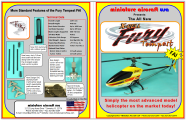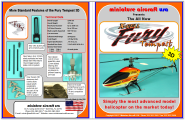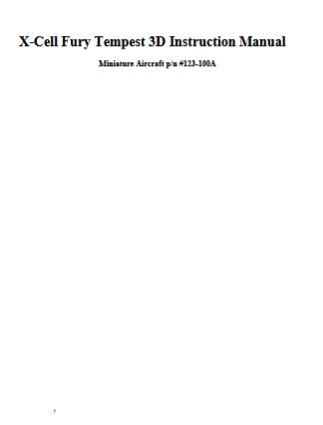MA - Miniature_Aircraft

Tempest FAI Manual
Tempest drawings
Tempest 3D Manual
Tempest 3D drawings
3D instructions
Tempest Rotor Head Setup - By Cliff Hiatt
I get a lot of requests for information about how I setup my models, so here are my recommendations for setting the Tempest rotor head up for FAI style flying. Keep in mind that my setup includes ALL of these recommendations. If you intend to use only some of them, you may need to make other changes to get the best results.
Damping:
I've found that installing the 50 durometer dampers dry (with no lubricants) and using a .25mm shim on each side give pretty close to linear damping rates and flew the best for me. For those of you familiar with the dreaded “wobble” that you often see happen to helicopters, using linear damping seems to be the trick in preventing it.
Fly bar Paddles
The head will support both short and long fly bars and has been successfully tested with paddles as heavy as 50 gms. The fly bar supplied with the kit will work with whatever paddle weight you want, however most contest pilots use a weight between 35 gms and 45 gms.
Of course any of the fly bar lengths that MA manufactures can be used. Use the combination of fly bar length and paddle weight that suits your flying style. I personally like the 568-1 long flybar and the 123-03 Pro-3 flybar paddles weighted to 42 gms
Bell/Hiller Mixing:
I've found good results using the 1 to .90 ratio.
Delta Offset
I'd recommend using the 3.3 mm negative delta offset option. As to whether it is positive or negative correction, there has been a lot of discussion regarding this subject lately, (especially on the online forums) about the pros and cons of each. Using one or the other will depend on whether you believe the blade disc is upset by wind gusts or the helicopter body is. As I discussed earlier, it is easy to change the head setup to achieve whichever you want.
Rotor Blades
I would recommend that you use 700mm blades that weigh in at approximately 200 grams. This is mostly because heavier blades can effect gyroscopic precession issues in aerobatics. Use whatever blade profile suits your style of flying as the head has been tested with symmetrical, semi-symmetrical and progressive profile, all with good results.
I am currently using 700mm Hi-Products TZ-91 II blades that weigh about 200 gms.
Head Speeds:
I have hovered this head down to 1150 rpm, but it seems to be happiest hovering in the 1400 – 1500 rpm range. Depending on the length of rotor blades, I'd recommend 1850-1950 RPM for crisp aerobatics.
Special Mixes
Using this head, I have eliminated all of the mixes that I thought I needed with the Pro-2 head and to a lesser extent the 848 heads. However, I’m not so convinced that they were ever necessary with those heads. It could just be that the pilot was at fault! <Grin> In other words, no special mixes should be needed to correct any bad tendencies. It doesn't have any!




